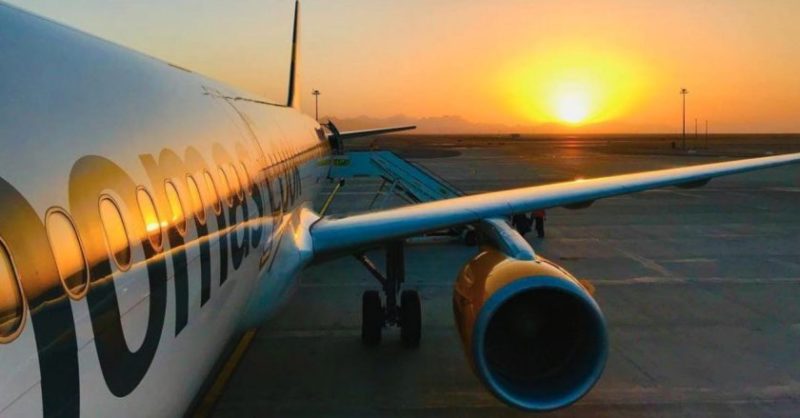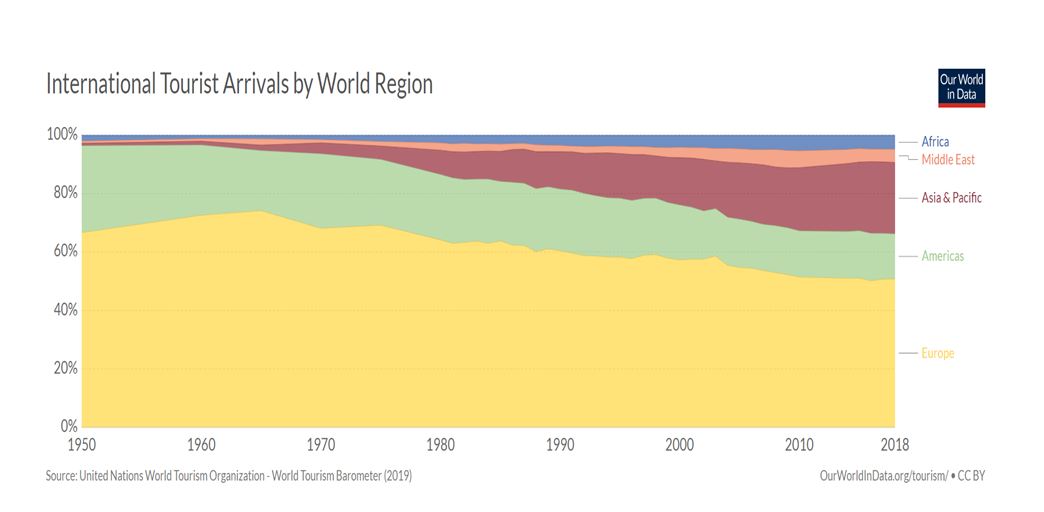Excerpts of our July anticipations on European tourism… (in the context of the failure of Thomas Cook)

Over the next decade, the impact of a downturn, combined with the effects of increased competition, saturation and fatigue, and environmental considerations, all this in the context of a vast questioning of meaning, will lead to a complete repositioning of the European tourism sector.
Reality has begun to remind Europe of the unsustainable nature of old-fashioned tourism in a century and a world that promises an explosion in the flow of tourists. Far from being able to continue to welcome half of this leisure travel, as is currently the case, Europe will have to protect itself from it.
If this trend represents a crisis for all the players who will continue to rely on quantitative tourism, it will also provide a set of creative constraints that will allow Europe to carry out innovative experiences of high quality “protectionist tourism”!
The plague of tourism: kill or cure
One thing is for sure, little Europe cannot continue to welcome 51% of the world’s tourists in the context of the increases we have just mentioned (which, according to estimates, would give between 1.4 and 1.9 billion tourists in 2030, instead of the current 710 million).
Firstly, there is, of course, the question of the investment that such an increase in the capacity of tourist accommodation would require: the authorities are in debt and private investors, as suggested above, will be attracted primarily by other regions.
Secondly, there is also the question of space: there are still some pretty undeveloped places in Europe, but most of the sites with the highest potential have already been optimised. There are still a lot of natural sites available. However, by definition, it is difficult to pour concrete on natural sites and then exploit them as natural sites… Apart from cities and sites, Europe is also an agricultural continent. So, it is difficult to requisition farmland to build Disneyland-like and other European Las Vegas type of attractions in regions without cultural or natural interest… Although it is probably along this path that European tourism is progressing…[1]
Thirdly, airspace[2] and airport capacity are overloaded and will not absorb the potential increased tourist flows. Local populations resist the building of new airports.[3] Also, “despite the call for private capital via privatisation, European airports will not be able to cope with traffic growth over the next 20 years.”[4]
Finally, and more than anything else, there is the fatigue that has been generated by over-tourism for several years now among Europeans, which makes it possible to anticipate that tourism development projects will increasingly come up against public opinion.
The well-known urban rallies of the inhabitants of Barcelona have had visible results and have started to “knock some sense into” the tourist sector of the city.[5] And while these first reconquista episodes took place in Spain, questions are being raised in other cities due to the deterioration of the habitat as a consequence of these over-tourism phenomena.
The city of Amsterdam has recently been added to the nascent movement of cities taking control of their destiny, announcing a series of particularly draconian measures: the end of guided tours of the red light district, the closing of reception and entertainment areas, measures to disperse tourists,[6] restrictions on Airbnb and equivalent rentals (prohibited completely in the tourist hotspots and prohibited beyond 30 days per year everywhere else),[7] increased tourist taxes,[8] etc. Such measures, taken by well-known cities, don’t go unnoticed and easily spread. Since the very first actions of this type in Barcelona, the cities concerned have begun forming networks like the “SET network” of cities of Southern Europe against tourism[9] or the Assembly of Neighbourhoods for Sustainable Tourism (ABTS). [10]
Hence it is the residents and their local elected representatives who are currently taking matters into their own hands – and very effectively – thus enshrining a governance model based on cities and networks of cities that we have long anticipated and whose positive effects we haven’t yet seen the end of. This is in huge contrast with the great paralysis and/or simplistic accounting mindset the national and supranational levels continue to demonstrate on a daily basis on this matter.[11] Municipalities will always need more taxpayers than tourists, even if the latters are overcharged. The excesses of the last few years are therefore coming to an end under the impetus of an informal yet highly effective local democracy…
The causes of over-tourism are already in the process of being resolved : Two phenomena have brought European tourism to the brink of explosion in recent years: low-cost flights and Airbnb (and equivalent facilities). The latter is by far the most significant, having helped in the massive expansion of the cities’ capacity to accommodate such visitors. But the resulting damage (desertification of historic centres, increased rents for the inhabitants, unbearable volumes of tourists, unfair competition for the hotel sector obliged to lower tariffs; loss by the local authorities of the power to regulate flow, and so on…) has highlighted the reality that massive tourism development has limits.
Low-cost airlines, on the other hand, are experiencing great difficulties,[12] inherently linked to a rationale of cheap ticketing, leading them to unbearable levels of tightening profit margins in the face of fierce competition. The growing debate over the pollution of high atmospheric strata with kerosene should soon lead, at least in Europe, to the introduction of a taxation policy that will put this type of company in serious trouble and trigger a process of higher-cost air travel. All this, as you will have understood, is already militating in favour of a profound rethinking of cheap tourism in Europe.
Changes in the political environment
While tourism is supposedly justified by the open-mindedness it provides, it is increasingly the opposite that is happening: visitors only interested in visiting bars, coffee shops and sex shops; exasperated hosts developing a negative view of foreigners in general. Tourism is far from nurturing a love for “others”. Our team would even go as far as to say that tourism in its current form is one of the factors in the rise of xenophobia… at least as much as economic and political migration.

The disfigurement of locations that the natives loved and of which they were proud is a major factor in residents’ perceptions of tourism. Characterised by the concreting of outstandingly beautiful sea coasts and the desertification of historic town centres, tourism is one of the factors in the acculturation of European populations, gradually relegated to suburbs and soulless tourist complexes. In addition to the deterioration of relationships with others mentioned above, we must also take into account the cultural and social impact of the phenomenon of remoteness of the resident populations from places linking them to the history and geography of their country… especially in a context of unprecedented challenges to integration.
This observation inevitably reflects the political developments of a continent whose countries are retreating into their identities in response to both a sense of invasion and increasing awareness of the destruction of the environment.
Meanwhile, these changes in public opinion are likely to be reflected increasingly in the decisions of national and especially local leaders. Indeed, while “populists” who rise to the national level may prefer to attack political/economic migrants than tourists, the trivialisation of a more or less harsh xenophobia will create a political environment for locally elected officials (in direct contact with public opinion) that is less and less tolerant towards tourist invasions. This political state of mind will be made acceptable by coupling it with an ecological discourse that also suggests a reduction of tourist flows.
All this fatigue with over-tourism will also result in a deterioration in the welcome given to tourists by local populations… which will be reinforced as the tourist contingents become more “exotic”.[13]
The European tourism sector has a real interest in anticipating reversals in tourism trends and especially in avoiding contributing to them. The principles of sustainable tourism[14] or the involvement of the population in tourism[15] that have already been advocated to reduce this fatigue effect will not be sufficient. In reality, they need to rethink the whole business model.
European tourism: The gap between hope and reality
Given the arguments developed above, the crisis we are anticipating is typical of the transition period we are currently experiencing. Whereas part of the tourism sector is betting on growth proportional to the increase in global tourist flows, its share of the market will, on the contrary, dwindle. Europe will lose its centrality both as an originator and as a host of tourist flows, under the combined effect of increased capacity and quality of tourist reception outside of the EU and the reaching of psychological and material limits within it. The trend is already underway, as is shown by the figure below.

Figure 2 – Access the link below to compare the data directly on the interactive graph. Source: United Nations World Tourism Organisation, 2019.
Hence it is a crisis of stabilisation that the European tourism sector will have to face: how to continue to grow in a context of slowing or even stagnation of flows and supply?
In an economic model still based on the principle of growth, the slowdown or stagnation will cause a crisis for all players in the sector who are currently counting on a continuous, even exponential, increase in the flow of tourists. And there are many who do so. The gap between hope and reality provides a measure for a crisis of frustrated plans.[16]
That said, while Europe accounts for 51% of global tourist flows, it gets only 39% of this receipts. The graph below clearly shows that the ratio of tourists to tourist revenues is not good in Europe.

Figure 3 – Ratio of tourists to tourist revenues
The only strategy that makes sense for European tourism will be to maximise the return per tourist (longer and/or more expensive stays), establishing an innovative and qualitative approach, while accepting the loss of our quantitative leadership.
Download the European tourism crisis file
______________________________
[1] This observation leads us to make the link with the free trade agreements that the EU is currently signing with Mercosur, as regards in particular to South American agricultural products. For a long time, leading experts have argued that the EU should abandon its principle of food self-sufficiency in order to buy from the highest bidder in this vast world and be able to exploit land differently. Certainly, the EU-Mercosur agreement that the Europeans are currently signing with their good friend, Jair Bolsonaro, is a new step in this direction. However it is still to be seen how much longer this kind of orientation will dominate the European agenda… Source: New Europe, 28/06/2019
[2] Source: Air Traffic Management, 28/03/2018
[3] Source: The Local, 17/01/2018
[4] Source: Les Echos, 01/08/2018
[5] The number of tourists in Spain continued to grow until 2017. However, since then, it has started to go down. Source: TradingEconomics
[7] Source: Forbes, 17/05/2018
[8] Source: Amsterdam.nl, 03/10/2018
[9] Source: TheLocal, 27/04/2018
[10] Source: AssembleaBarris, 18/06/2019
[11] In reality, national and supranational tourism policies are guided only by incremental goals… even if the word “sustainable” spices up their reports. The French Court of Auditors is challenging Languedoc-Roussillon for its poor tourist performance (source: La Tribune, 07/02/2018); Greece is calling for a unified tourism policy… with a financial focus, of course (source: GTP, 27/02/2019); there is an obsession with remaining No.1 at the European level (source: Commission européenne); etc.
[12] Source: Fortune, 07/04/2019
[13] Switzerland, whose mountains have served as a dream setting for many Bollywood film makers, is one of the favourite destinations for Indian tourism in Europe. The country aims to host 1 million Indians in 2020 (source: Times of India, 14/11/2018). But the conservative character of the Swiss makes us doubt their willingness to see their landscapes covered with Indian restaurants to feed groups of tourists who will certainly not be interested in Swiss culture, particularly food, convinced as they are by their cinema that Switzerland is Indian. We don’t doubt that, beyond certain limits, the lure of profits from tourism will run up against the grumbling of the natives.
[14] Source: European Commission
[15] Source: European Commission
[16] France, boosted by the growth of tourism at home, is proud to have attracted 14 billion in investments in 2018 (a record!). Let’s hope that most of those investments ultimately prove to have been wise. Source: VeilleInfoTourisme, 07/11/2018




Comments